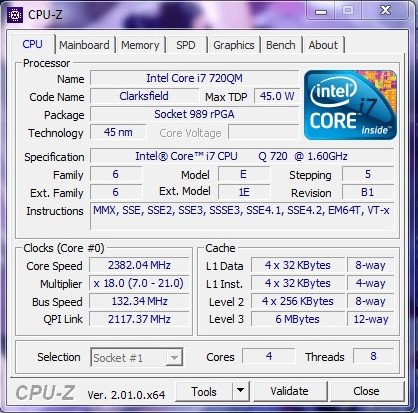Geekbench3 - Single Core score 1078 points with a i7-720QM
Thursday, 01 January 1970 07:00 | Update at null
Media Gallery
Screenshot

Device, Setup, etc



URL
https://hwbot.org/submission/5068114https://bit.ly/3R7RL3o
Information Detail
Hardware: Intel Core i7 720QM
Specs:CPUID : Intel(R) Core(TM) i7 CPU Q 720 @ 1.60GHz
Architecture : x86
Codename : Clarksfield
L3 Cache : 6MB
Clock : 1.60GHz - 2.80GHz
Core/Thread : 4/8
TDP : 45W
Technology : 45nm
Socket : PGA988
IGPU : -
See more specification...
Software: Geekbench3 - Single Core
Score: 1078 points
About: Geekbench3 - Single CoreGeekbench 3 – Single Core is part of a popular benchmark testing suite created by Primate Labs that focuses on measuring the single-core performance of a processor. This test is very important because many applications and everyday tasks, including games, browsers, and other lightweight applications, still rely heavily on the speed and efficiency of a single CPU core in completing instructions.
In Single Core mode, Geekbench 3 runs a series of workloads that include data compression, encryption, physics simulation, image processing, and data manipulation, but only uses one core of the tested processor. The results provide an accurate picture of the CPU core's ability to handle general workloads not designed for multi-threading. This is particularly useful for evaluating processor performance in everyday usage scenarios.
Geekbench 3 Single Core scores are an important indicator for comparing processor architecture efficiency, operating frequency, and instructions per clock (IPC) capabilities between different CPU models, whether from the same generation or different ones. A high score indicates that the CPU can complete important tasks faster and more responsively even without utilizing multiple cores.
The advantage of Geekbench 3 lies in its cross-platform approach. This benchmark can be run on Windows, macOS, Linux, and mobile devices such as Android and iOS, allowing users to compare performance across devices consistently. This makes Geekbench 3 one of the most flexible and reliable benchmarking tools for measuring modern computing performance.
With a focus on Single Core Performance, Geekbench 3 provides valuable insights for users who rely on optimal performance in lightweight applications or scenarios where response speed is a top priority.
The Intel Core i7-720QM, launched in Q3 2009, was one of the first mobile quad-core processors to feature Intel's Nehalem microarchitecture, specifically the Clarksfield variant. Targeted at high-performance laptops, such as gaming machines and mobile workstations, the i7-720QM brought 4 physical cores and 8 threads to the mobile platform, thanks to Hyper-Threading Technology providing a significant boost in multi-threaded workloads like video editing, 3D rendering, and other professional-grade applications. The processor runs at a base clock speed of 1.6 GHz, but it can dynamically increase up to 2.8 GHz using Intel Turbo Boost, depending on thermal headroom and power availability.
Manufactured using a 45nm process, the i7-720QM has a TDP of 45W, which is quite high by today's mobile CPU standards. This thermal demand necessitated more robust cooling solutions in laptops that featured the chip. Unlike modern CPUs, the i7-720QM does not come with integrated graphics, which means systems based on this processor require a dedicated GPU often from AMD or NVIDIA for graphics processing and display output. As such, it was typically paired with mid-to-high-end discrete graphics cards in its time, making it a solid choice for gaming and multimedia laptops in the late 2000s and early 2010s.
While the Core i7-720QM was a powerhouse during its release, its performance and efficiency are significantly outpaced by modern CPUs built on smaller nodes and with higher IPC (Instructions Per Clock). Nevertheless, legacy laptops using the i7-720QM can still be viable for basic computing tasks like web browsing, document editing, or watching videos especially if paired with an SSD upgrade and increased RAM. Users running Windows 10 on such systems may experience some limitations, but with proper optimization and lightweight software, the CPU can still deliver a usable experience in non-demanding environments.
Hardware Detail:
Device: HP Pavilion dv3-4054TX
RAM: 4GB DDR3 Single Channel
OS: Windows 7, Windows 10
* Not Avaiable
